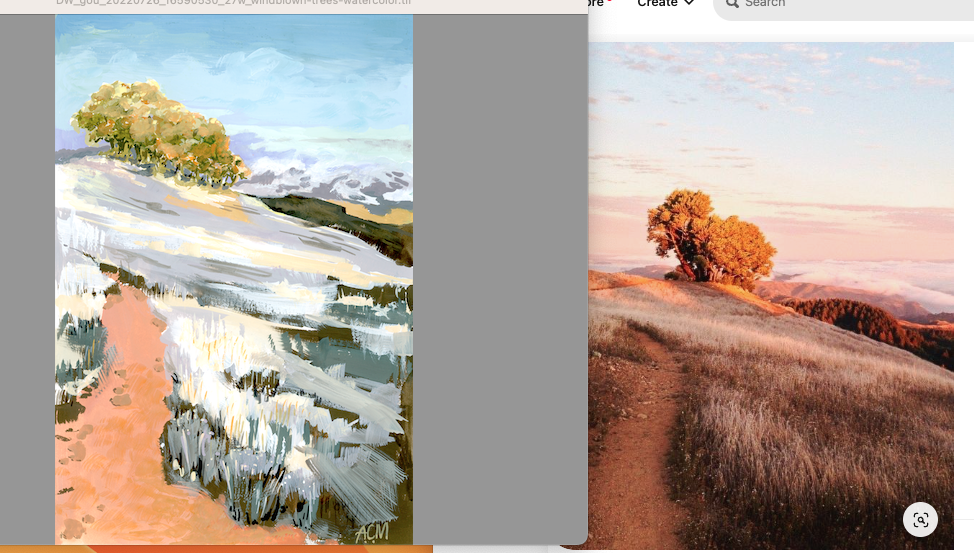My art on Driftwilde.com is inspired occasionally by photographs and artwork by other artists. Part of my decision about selecting my portfolio of original and print artworks for sale is based on an assessment of originality for each art piece. I review each one for the potential for infringement of artwork copyrights.
The question is: Where is the line between my artwork being original versus it being perceived as a copy of someone else’s work?
Sources of inspiration
My sources of inspiration include plein air settings, my imagination, and photo images.
It’s very common among artists to use photos as a source of inspiration. Currently, I don’t use a free stock image source application. Instead like many other artists, I might use an image from the Internet (Instagram, Google, Pinterest, online articles, blogs, etc.), magazines and other sources.
To sell or not sell artwork?
If you’re considering selling your artwork, be sure to consider its originality. I try thinking about how the first artist would feel about me selling my version as original, which is inspired by the art of the other artist. If you have any doubt, make a point of reaching out to the first artist to see if they have any concerns. For me, the “first artist” typically is a photographer.
Use your sleuthing skills
Finding contact information for the first artist can be a bit of a challenge. For example, if the image was from an online article, try looking for the artist’s email address at the end of the article or right click on the image to see if the metadata can be inspected where you may be able to find the name of the artist, or the name of the artwork. Additionally, you can check for contact information for the article’s author or publisher in order to track down the artist. The point is, it’s your responsibility to be in direct contact with the first artist. Sometimes, I found it took a few tries.
Contact the artist
The easiest method to contact the artist is to email them your inquiry. In your correspondence, be sure you provide a brief introduction and reason for contacting them, the title of the image/artwork, or where you came across it to help convey which photo is being discussed.
If the artist responds to your query with either a yea or nay, you know conclusively where they stand. Be sure to give a reasonable period of time for the response. To be fair, I’d give two weeks or longer if you can. Otherwise, you may have to base your decision to sell on other parameters. Alternatively, you can avoid the potential for copyright infringement by deciding to not sell the image as original artwork (including reprints) or as digital downloads. The safest approach would be the latter one.
How original is original?
In the examples below, I pair my artwork with the art of the first artist from the perspective of evaluating artwork copyright infringement. Each comparison shows my artwork on the left and the first artist’s work on the right.
In all comparisons, you can see clearly that the images are connected by subject, but the outcomes are different. Just as two people have different “takes” painting the same model or subject matter in an art class or in a plein air setting, the same is true in these comparisons.
Looking more closely at comparisons 1 and 2, I decided to contact the artists for their thoughts just to be on the safe side. In the first two comparisons, the photographer’s image was in an online article. In the first comparison, the author provided an email address for the photographer. I the second comparison, the publisher, monrovia.com responded directly. In both instances, I was given the “green light” to feel free to “sell away”; no infringement was noted of artwork copyrights.
You should also add a photo credit if you publish information with images of creative works by others. It’s a show of respect and an industry standard. Regarding providing a photo credit, I received two types of responses even when no copyright infringement was noted. In the photoimage in Comparison 1, the photographer responded with no need for a photo credit. In Comparison 2, the publisher provided a photo credit.





Originality comparison notes
In comparisons 3-5, you can see the influence of the photoimage on my artwork. However, for these examples, I didn’t feel there was a sufficient likeness between the two artworks to contact the photographer. The following comments reflect my originality evaluations for comparisons 3, 4, and 5:
— Note that in Comparison 3, the grid used to help set a focal point is different, the subject matter is in a different season, the color palettes are dramatically different, and the details on vegetation are distinct.
— Similarly, in Comparison 4, the styles and perspectives differ, as do the color palettes, details of vegetation, and the lighting and ambiance.
— And in Comparison 5, the styles and color palettes differ, as well as the focal points, architectural structures and landscaping.
It’s fascinating to see how differently artists see things. In fairness to the other artists whose works you find inspiring, it’s worth going through an evaluation of originality if you have any doubt!
Copyright 2023-2024 Driftwilde | Privacy Policy | Disclaimer | Terms and Conditions